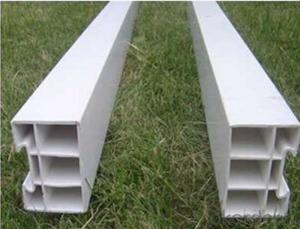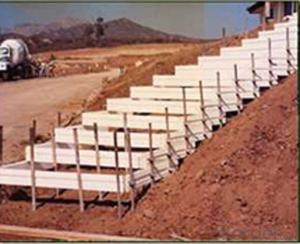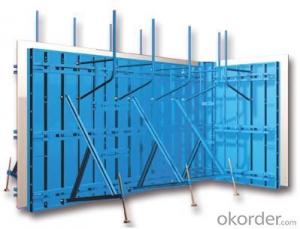Mobile Scaffolding Platform Formwork Scaffolding Connector with Great Price
- Loading Port:
- Tianjin
- Payment Terms:
- TT OR LC
- Min Order Qty:
- 6000 set
- Supply Capability:
- 50000 set/month
OKorder Service Pledge
OKorder Financial Service
You Might Also Like
Mobile Scaffolding Platform Formwork Scaffolding Connector with Great Price
Scaffolding Screw Jack Formwork Scaffolding China Low Price
Developing with new technology materials, steel formworks is no longer a must in construction concrete process. More and more buildings are established with plastic formworks. And workers love this new formworks much more.
The advantages of plastic formworks:
Scaffolding Screw Jack Formwork Scaffolding China Low Price
1.First of all--light
Yes it is the first advantage of plastic formwork. It wins the great praise of both contractors and workers.
The biggest panel is 120×1500px,weights 10.5kg only. It can be lift and set up by one person easily, which means there is no need for cranes on site.Saves a lot of cost and time.
2.Easy set up
Different size of panels can firmly locked by simply turn the special handles to 90 degree. The Panels has rib on the back, which makes the system need not traditional wood blocks and nails. The panels have holes to fit tie rod, guarantee the strength of the whole system.
3.Modularity
Modular formworks composed by different size of panels,the main item is 120×1500px panel,which is used for the large area of walls and slabs. There are also small size of panels like 10×1500px,20×1500pxcm,25×1500px,inner corner 20×20×1500px and outer corner 10×5×1500px.Due to the variety of panel size, the system can form almost all size walls 120×1500px panel of multiply by 125px. The material of modular formwork is PC-ABS mixed with special glass fibers which enable panels to hold high pressures.
4.Strength
The handles are made by high strength Nilon, each panel locked by at least 4 handles, which makes the whole system strong enough to pour 1000px walls.
Mobile Scaffolding Platform Formwork Scaffolding Connector with Great Price
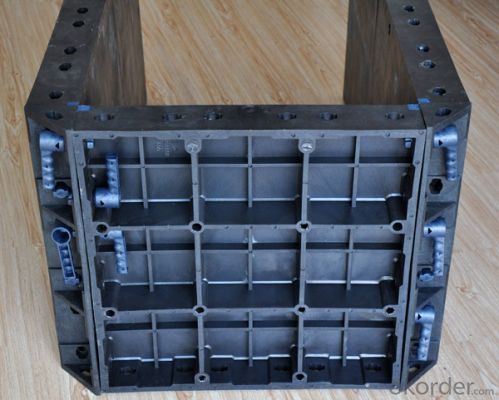
Mobile Scaffolding Platform Formwork Scaffolding Connector with Great Price
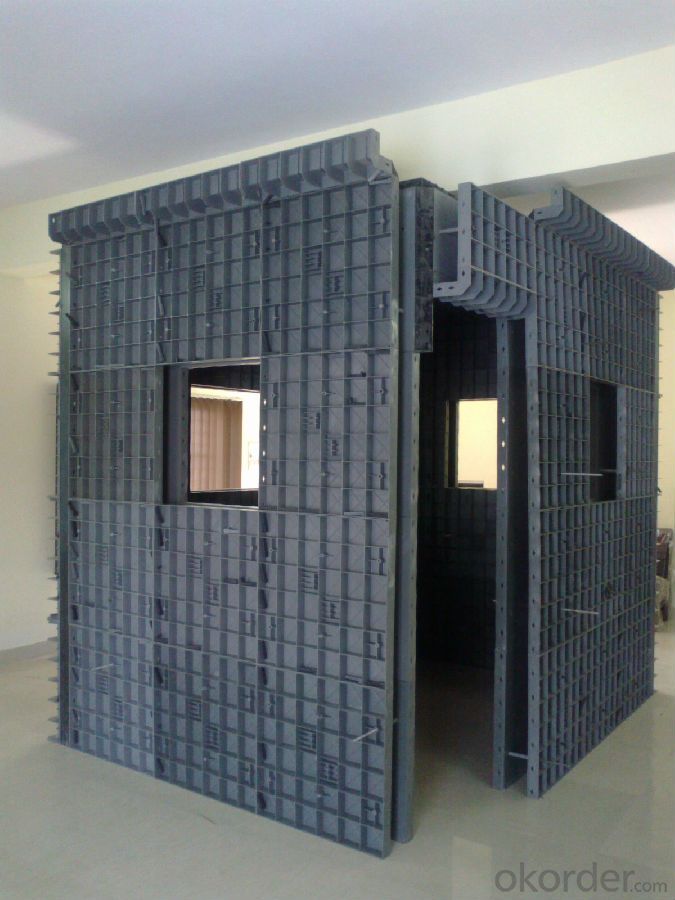
Mobile Scaffolding Platform Formwork Scaffolding Connector with Great Price
- Q:How does steel frame formwork affect the overall cost of concrete construction?
- Steel frame formwork can have a significant impact on the overall cost of concrete construction. While it may require a higher initial investment compared to other formwork systems, the use of steel frame formwork offers several advantages that can result in long-term cost savings. Its durability and reusability make it a cost-effective option, as it can withstand multiple construction cycles without significant wear and tear. Additionally, steel frame formwork allows for faster construction times, reducing labor costs. Its modular design and ease of assembly also contribute to increased efficiency and reduced construction time, further lowering overall costs.
- Q:How does steel frame formwork help in reducing formwork assembly time?
- There are several ways in which formwork assembly time can be reduced with the help of steel frame formwork. To begin with, steel frame formwork is designed to be lightweight and easily adjustable, making it quick and convenient to assemble. The steel frames are typically pre-fabricated and can be easily connected together, allowing for rapid installation. This eliminates the need for complex and time-consuming assembly processes, such as cutting and shaping wooden formwork. Furthermore, steel frame formwork is highly durable and can be reused multiple times. This saves time and effort as the same frames can be used for multiple projects. In contrast, traditional wooden formwork often needs to be built from scratch for each project, increasing the overall assembly time. Moreover, steel frame formwork provides excellent stability and support, reducing the need for additional bracing and support systems. This saves time during assembly as there is no need to spend extra effort on reinforcing the formwork structure. The strong and rigid steel frames can withstand the pressure of the concrete, reducing the risk of formwork failure during the pouring process and minimizing the time spent on repairs or adjustments. Additionally, steel frame formwork allows for efficient and precise concrete pouring. The frames are designed with accurate dimensions, ensuring proper alignment of the formwork. This eliminates the need for extensive adjustments during the pouring process, saving time and reducing the risk of errors. The precise alignment also enables faster removal of the formwork after the concrete has cured, further reducing the overall assembly time. In conclusion, steel frame formwork contributes to a faster and more efficient construction process by offering a lightweight and easily adjustable design, durability for multiple uses, stability and support, and efficient concrete pouring capabilities. These features result in reduced formwork assembly time, ultimately improving overall productivity.
- Q:The displacement of the H/500 steel structure design code page 121 A.2 multilayer framework, the relative displacement between layers of multilayer frame h/400. With the gauge gauge 5.5.1 multi, high-rise steel structure 1/300.I would like to ask the multi-storey frame structure of the inter story displacement in the end how to control it?
- Displacement in two cases:One is the seismic control by 1/250One is the wind, according to 1/400 control"Steel regulations" and "Regulations" said the top can be relaxed, the industrial plant can be further relaxed.But there is no specific how much can be relaxed.
- Q:What is the cost of steel frame formwork compared to other types of formwork?
- The cost of steel frame formwork is generally higher compared to other types of formwork materials such as wood or aluminum. However, steel frame formwork offers several advantages such as durability, reusability, and high load-bearing capacity, which can offset the initial investment. Additionally, the long-term cost-effectiveness of steel frame formwork can be higher due to its prolonged lifespan and reduced maintenance requirements.
- Q:What are the different types of supports and props used with steel frame formwork?
- Steel frame formwork systems commonly utilize various types of supports and props to ensure stability and support. These components are crucial for proper formation and maintenance of the concrete structure throughout the construction process. Some examples of supports and props used in conjunction with steel frame formwork are as follows: 1. Adjustable Steel Props: Telescopic steel tubes that can be adjusted to different lengths are frequently employed to support horizontal formwork elements like beams and slabs. Their adjustable feature enables easy height adjustment and guarantees stability during concrete pouring. 2. Tripod Supports: These supports consist of three legs with adjustable heights and are used to support vertical formwork elements, such as columns and walls. Tripod supports offer stability and can be easily adjusted to accommodate various formwork heights. 3. Soldier Props: Vertical supports made of steel, soldier props are commonly used to support vertical formwork elements like walls. They are adjustable in height and provide stability. Soldier props are often used in conjunction with other supports to enhance reinforcement. 4. Scaffolding: Scaffolding is a temporary structure used to support workers and materials during construction. It is frequently employed alongside steel frame formwork systems to provide additional support and access to different areas of the structure. Scaffolding is usually constructed of steel or aluminum and can be easily assembled and disassembled. 5. Formwork Brackets: These brackets are used to support horizontal formwork elements, such as beams and slabs. They are typically attached to the structure using bolts or clamps and provide extra support and stability during concrete pouring. Formwork brackets are often adjustable to accommodate different formwork heights and configurations. 6. Wall Ties: Wall ties are used to hold formwork panels together and provide stability to vertical formwork elements like walls. Typically made of steel, they are secured to the formwork panels using nuts and bolts. Wall ties ensure the formwork panels remain in place during concrete pouring and curing. In summary, the diverse range of supports and props used with steel frame formwork systems are meticulously designed to offer stability, support, and flexibility during the construction process. These components are essential in maintaining the formwork in place, enabling the proper formation of concrete structures.
- Q:How does steel frame formwork handle the placement of reinforcement bars within the concrete structure?
- Steel frame formwork handles the placement of reinforcement bars within the concrete structure by providing a rigid framework that holds the bars in place during the pouring and curing process. The steel frame formwork ensures that the reinforcement bars are positioned correctly and securely, preventing any movement or displacement that could compromise the strength and structural integrity of the concrete.
- Q:What are the different types of steel used in steel frame formwork systems?
- There are several types of steel commonly used in steel frame formwork systems. The choice of steel depends on factors such as load capacity, durability, and cost. 1. Mild Steel: This is the most common type of steel used in formwork systems. It is known for its strength and affordability. Mild steel is suitable for most construction applications and can handle moderate loads. 2. High-Strength Low-Alloy (HSLA) Steel: HSLA steel is a type of steel that offers higher strength and better corrosion resistance compared to mild steel. It is commonly used in applications that require increased load capacity and durability. 3. Alloy Steel: Alloy steel is made by adding elements such as chromium, nickel, or molybdenum to improve its mechanical properties. It offers increased strength, hardness, and resistance to wear and tear. Alloy steel is often used in heavy-duty formwork systems that require high load-bearing capacity. 4. Stainless Steel: Stainless steel is known for its excellent corrosion resistance. It is commonly used in formwork systems that are exposed to harsh environments, such as marine or chemical plants. Stainless steel is more expensive than other types of steel but provides long-lasting performance. 5. Carbon Steel: Carbon steel is a type of steel that contains carbon as the main alloying element. It offers good strength and durability, making it suitable for various formwork applications. Carbon steel is also commonly used in combination with other materials, such as concrete, to provide additional reinforcement. It is important to select the appropriate type of steel for a steel frame formwork system based on the specific requirements of the construction project. Factors such as load capacity, durability, and budget should be considered to ensure the success of the formwork system.
- Q:How does steel frame formwork ensure proper consolidation of concrete?
- Steel frame formwork ensures proper consolidation of concrete by providing a rigid structure that holds the freshly poured concrete in place. The steel frame acts as a mold or a template, allowing the concrete to be poured and shaped according to the desired design. This formwork holds the concrete in position until it fully hardens and gains strength. Additionally, the steel frame formwork is designed with appropriate spacing and supports to prevent any movement or deformation of the concrete during the consolidation process. This ensures that the concrete is compacted uniformly, resulting in a strong and durable structure.
- Q:How does steel frame formwork affect the overall quality of the concrete structure?
- The utilization of steel frame formwork is essential for maintaining the overall quality of a concrete structure. This specific formwork system serves as a robust and inflexible framework that provides support for the wet concrete throughout the pouring and curing stages. Its design is intended to withstand the pressure exerted by the concrete, ensuring that it retains its shape and integrity until it solidifies. An important advantage of using steel frame formwork is its capacity to produce smooth and precise concrete surfaces. The steel panels are manufactured with high precision, ensuring that they fit together seamlessly to create a uniform surface. This results in a finished concrete structure that is devoid of defects such as unevenness, honeycombing, or formwork marks. Furthermore, the smooth surface enhances the aesthetic appeal of the structure. Furthermore, steel frame formwork offers exceptional dimensional accuracy to the concrete structure. The rigid steel framework guarantees that the dimensions of the formwork remain consistent and do not change during the pouring process. This helps eliminate any variations or distortions that may occur due to the weight or pressure of the wet concrete. Consequently, the final structure is constructed according to exact specifications, ensuring precision and reliability. Another benefit of utilizing steel frame formwork is its durability and reusability. Steel is a sturdy material that can withstand the harsh conditions of construction sites, such as heavy loads, vibrations, and exposure to weather elements. This durability allows the formwork to be utilized multiple times, reducing construction costs and minimizing waste. Additionally, the ability to reuse the formwork maintains consistency and quality across multiple projects. Moreover, steel frame formwork provides excellent structural stability and strength to the concrete structure. The steel panels and supports are designed to withstand the pressure exerted by the wet concrete, ensuring that the formwork remains stable and secure. This stability is crucial in preventing any deformation or collapse during the pouring and curing process, which could compromise the overall quality and safety of the structure. In conclusion, the utilization of steel frame formwork significantly influences the overall quality of a concrete structure. It ensures smooth and precise surfaces, dimensional accuracy, durability, and structural stability. By providing a strong and inflexible framework, steel formwork contributes to the creation of high-quality, aesthetically pleasing, and dependable concrete structures.
- Q:Are steel frame formwork systems adjustable?
- Yes, steel frame formwork systems are adjustable. These systems are designed to be flexible and adaptable to various construction projects. The steel frames can be easily adjusted to different sizes and shapes, allowing for customization and versatility in formwork construction.
1. Manufacturer Overview |
|
|---|---|
| Location | |
| Year Established | |
| Annual Output Value | |
| Main Markets | |
| Company Certifications | |
2. Manufacturer Certificates |
|
|---|---|
| a) Certification Name | |
| Range | |
| Reference | |
| Validity Period | |
3. Manufacturer Capability |
|
|---|---|
| a)Trade Capacity | |
| Nearest Port | |
| Export Percentage | |
| No.of Employees in Trade Department | |
| Language Spoken: | |
| b)Factory Information | |
| Factory Size: | |
| No. of Production Lines | |
| Contract Manufacturing | |
| Product Price Range | |
Send your message to us
Mobile Scaffolding Platform Formwork Scaffolding Connector with Great Price
- Loading Port:
- Tianjin
- Payment Terms:
- TT OR LC
- Min Order Qty:
- 6000 set
- Supply Capability:
- 50000 set/month
OKorder Service Pledge
OKorder Financial Service
Similar products
New products
Hot products
Hot Searches
Related keywords
